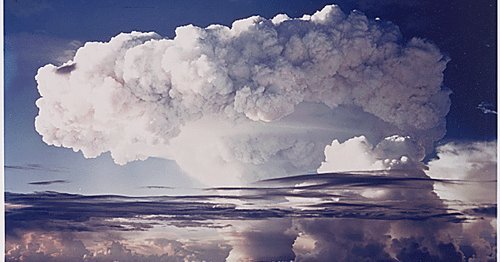There was an October 2007 Israeli air strike in Syria directed against an alleged nuclear facility under construction, but the nature of this facility has not been confirmed. Thus, non-governmental voices need to be raised with positive suggestions of confidence-building measures and calls for serious political negotiations.
Largely absent from newspaper headlines have been the UN General Assembly resolutions calling for a Nuclear-weapon Free Zone in the Middle East. Such a resolution was first introduced by Egypt and Iran in 1974 and a largely similar resolution has been adopted each year by consensus since 1980.
Are these resolutions a “feel good” habit or is the world community advancing slowly toward building slowly such a nuclear-weapon free framework. One close observer has called for a much faster pace. Mohamed ElBaradei, the Director General of the UN’s International Atomic Energy Agency (IAEA) has repeatedly called up Iran and Israel in particular to create a nuclear-weapon free zone in the Middle East. He indicates that time is short and has stressed that a peace agreement between Israel and its Arab neighbors “must be reached in parallel with a security agreement in the region based on ridding the region of all weapons of mass destruction.”
Nuclear proliferation in the Middle East
The hazards of nuclear proliferation in the Middle East have existed since Israel developed its “bomb in the basement” and was widely discussed in the early 1980s after Israeli forces destroyed the French-built nuclear reactor near Baghdad in June 1981. [1]
Among the community of international relations scholars and strategic theorists, nuclear proliferation has always had a few ardent supporters who believe that security is increased by enlarging the number of states with credible deterrence. This view of nuclear proliferation is often referred to as the “porcupine theory” because it suggests that a nuclear weapon state can walk like a porcupine through the forests of international affairs: no threat to its neighbors, too prickly for predators to swallow.
It was the French Air Force General Pierre Gallois who was the most eloquent champion of the porcupine approach writing “If every nuclear power held weapons truly invulnerable to the blows of the other, the resort to force by one to the detriment of the other would be impossible.” However, the Middle East is filled not with porcupines but with men who may not be immune to irrationality. Irrationality at national leadership levels is known in world politics, and risk-taking even by rational leaders can get out of control. Thus, with the current impossibility of having a nuclear-weapon-free world, the concept of regional nuclear-weapon-free zones has spread.
Nuclear-weapon-free-zones
The concept of nuclear-weapon-free zones has been an important concept in disarmament and regional conflict reduction efforts. A nuclear-weapon-free zone was first suggested by the Polish Foreign Minister Adam Rapacki at the United Nations General Assembly in October 1957 — just a year after the crushing of the uprising in Hungary. The crushing of the Hungarian revolt by Soviet troops and the unrest among Polish workers at the same time showed that the East-West equilibrium in Central Europe was unstable with both the Soviet Union and the USA in possession of nuclear weapons, and perhaps a willingness to use them if the political situation became radically unstable.
The Rapacki Plan, as it became known, called for the denuclearization of East and West Germany, Czechoslovakia and Poland. The Plan went through several variants which included its extension to cover the reduction of armed forces and armaments, and as a preliminary step, a freeze on nuclear weapons in the area. The Rapacki Plan was opposed by the NATO powers, in part because it recognized the legitimacy of the East German state.
It was not until 1970 and the start of what became the 1975 Helsinki Conference on Security and Cooperation in Europe that serious negotiations on troop levels and weapons in Europe began. While the Rapacki Plan never led to negotiations on nuclear-weapon policies in Europe, it had the merit of re-starting East-West discussions which were then at a dead point.
Cuba
The first nuclear-weapon-free zone to be negotiated — the Treaty of Tlatelolco — was a direct aftermath of the Cuban missile crisis of October 1962. It is hard to know how close to a nuclear exchange between the USA and the USSR was the Cuban missile crisis. It was close enough so that Latin American leaders were moved to action. While Latin America was not an area in which military confrontation was as stark as in Europe, the Cuban missile crisis was a warning that you did not need to have standing armies facing each other for there to be danger.
Mexico
Mexico under the leadership of Ambassador Alfonso Garcia-Robles at the UN began immediately to call for a denuclearization of Latin America. There were a series of conferences, and in February 1967 the Treaty for the Prohibition of Nuclear Weapons in Latin America was signed at Tlatelolco, Mexico. For a major arms control treaty, the Tlateloco was negotiated in a short time, due partly to the fear inspired by the Cuban missile crisis but especially to the energy and persistence of Garcia-Robles and the expert advice of William Epstein, then the U.N.’s Director of Disarmament Affairs. The Treaty established a permanent and effective system of control which contains a number of novel and pioneering elements as well as a body to supervise the Treaty.
Central Asia
On 8 September 2006, the five states of Central Asia — Kazakhstan, Kyrgyzstan, Uzbekistan, Tajikistan, and Turkmenistan signed the treaty establishing a nuclear-weapon-free zone. The treaty aims at reducing the risk of nuclear proliferation and nuclear-armed terrorism. The treaty bans the production, acquisition, deployment of nuclear weapons and their components as well as nuclear explosives. Importantly, the treaty bans the hosting or transport of nuclear weapons as both Russia and the USA have established military airbases in Central Asia where nuclear weapons could have been placed in times of crisis in Asia.
It is an unfortunate aspect of world politics that constructive, institution-building action is usually undertaken only because of a crisis.
The treaty was signed at Semipalatinsk, Kazakhstan which was the main testing site for Soviet nuclear tests. Between 1949 and 1989, some 500 nuclear tests took place at Semipalatinsk leaving a heritage of radioactivity and health problems. A non-governmental organization “Nevada-Semipalatinsk” was formed in the 1980s of persons in the USA and the USSR who had lived in the nuclear-weapon test areas. Its aim was to work to abolish nuclear weapons and to push for compensation for the persons suffering from the medical consequences of the tests. Thus, Rusten Tursunbaev, the vice President of “Nevada-Semipalatinsk” could say “The signing of the agreement on a nuclear-weapon-free zone in Central Asia is a remarkable, unbelievable moment and event — not just for Central Asia, but for the whole world.”
It is an unfortunate aspect of world politics that constructive, institution-building action is usually undertaken only because of a crisis. The growing pressure building in the Middle East could lead to concerted leadership for a Middle East nuclear-weapon-free zone. The IAEA has the technical knowledge for putting such a zone in place. [2] Now there needs to be leadership from within the Middle East states as well as broader international encouragement. ElBaradei’s appeal may be the sign of a serious start.


Follow the comments: |
|
